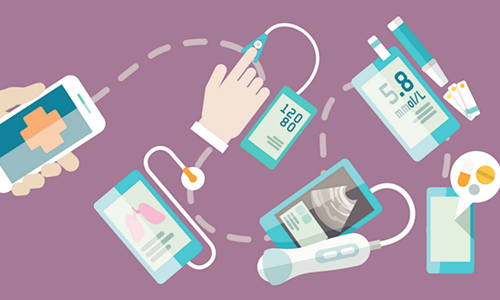How to overcome digital documentation challenges in health care
February 24, 2018
Source: healthcarebusinesstech
 785
785

The mobile health industry is exploding, and it’s not just because more Americans than ever own smart devices. Providers and patients alike are realizing real value in mobile health technology as advancements ease the path to greater efficiency and lower costs.
But as mobile health funding approaches $1.3 billion and the number of mobile health apps exceeds 165,000, one disconnect remains. According to the Healthcare Information and Management Systems Society (HIMSS), no mobile medical device will be meaningful until it’s able to “capture and exchange information with key systems.” In other words, mHealth must connect to eHealth to be beneficial. In this guest post, Chris Byers, CEO of a company that offers an online form and data-collection platform, details how recent advancements in mobile medical forms make it possible to consolidate disparate patient data and healthcare processes into one streamlined system in ways other mobile technology can’t.
Challenges of digital documentation
As providers move away from the quantity of patients seen to the quality of care received, one mission-critical component still stands in the way for even the most prepared practices: digital documentation. Despite the rapid growth of electronic health records (EHRs), many systems remain shrouded by a cloud of tedious, time-consuming tasks and security concerns.
Without the ability to capture patient data before and after care, providers are often forced to click their way through patient visits. And as the amount of time clinical staff devotes to manual data entry increases – physicians are currently spending two-thirds of their time on paperwork – so does the likelihood of user error. Add in the fact that healthcare information is 100 times more valuable than stolen credit cards and the risk of a healthcare hack magnifies with each unintentionally exposed patient record and unencrypted storage drive.
With clinical staff continually crunched for time when recording patient interactions, it’s becoming increasingly difficult to keep these dangers at bay. It’s a vicious cycle, but it doesn’t have to continue.
For healthcare technology to be effective, simplicity and security are key. That’s where mobile-friendly, HIPAA compliant online form solutions come in.
Power of mobile form solutions
A mobile-friendly online form solution can collect critical patient information and maintain HIPAA data security with little pain, maintenance or downtime. A secure, cloud-based form builder helps keep patient data secure, reduce administrative costs and improve the patient experience. HIPAA compliant mobile healthcare forms remove the burden of many repetitive tasks and time-consuming paperwork while addressing several mission-critical areas.
Patient data security
HIPAA compliant online forms can help reduce security risks through:
Continual updates – Annual audits and new employee training ensure HIPAA compliance remains intact.
Access controls – User-level permission settings and password protection helps keep patient information safe from potential internal leaks.
Advanced data encryption – All data collected through an online form solution should be protected by mandatory encryption technology that’s compliant with HIPAA and HITECH (Health Information Technology for Economic and Clinical Health Act).
Security testing – Simple security tests can be created and sent to in-house staff as a way to help train employees to recognize and protect against phishing scams and attempted data breaches.
Administrative costs
Mobile online forms reduce administrative costs by:
Increasing accuracy – Short-answer fields, radio buttons and checkboxes eliminate the need for handwritten information and drastically reduce the likelihood of transcription errors.
Ensuring completeness of records: – Required fields ensure a form won’t be submitted (and thus, information won’t be routed to the EHR or other system) until all necessary information has been captured.
Streamlining interdepartmental communications – Collecting data online speeds up the patient registration process and puts less stress on all departments.
Facilitating provider-patient communications – Mobile-friendly forms empower patients to communicate with providers as questions and concerns arise, reducing the frequency of phone calls and unnecessary visits.
Reducing paper processes – Mobile-friendly online forms can replace many paper-based filing systems that lengthen patient onboarding and increase security risks.
Patient experience
Mobile online form solutions can improve the patient experience by:
Providing easy access to health information – Online forms allow for quick and easy access to important personal medical information that’s vital to improving patient outcomes.
Improving patient flow – Using mobile-friendly forms to collect information before the patient arrives for an appointment reduces wait times and patient flow bottlenecks.
Collecting real-time feedback – Online forms can be used to send quick post-visit surveys that automatically route answers to appropriate staff, whether it’s an employee in charge of handling customer service issues or a care manager who will benefit from additional insights.
As the challenges of digital documentation persist, providers need a reliable way to manage critically important, and highly sensitive, patient data. HIPAA compliant mobile forms make it possible to collect and share information across devices and systems, without having to worry about security or IT maintenance. Tasks that would normally begin in person, on paper or over the phone can now be accomplished in the cloud through mHealth solutions.
By Ddu
Read more on
- Disposable Medical Products that Keep Your Medical Facility Clean and Sterile March 31, 2022
- 10 Triumphant Drug Launches Of The Decade August 26, 2021
- Ultrasonic Nebulizer Market Views September 6, 2018
- 4 Best-Selling Digital Thermometers on Drugdu.com in 2018 September 5, 2018
- Don’t Miss These Tips before Your Cardiac Monitor Purchase September 5, 2018
your submission has already been received.
OK
Subscribe
Please enter a valid Email address!
Submit
The most relevant industry news & insight will be sent to you every two weeks.



